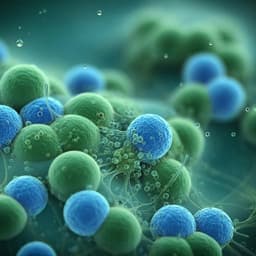
Environmental Studies and Forestry
Coagulation of trace arsenic and cadmium from drinking water using titanium potassium oxalate
J. Zhou, Y. Liu, et al.
Discover how titanium potassium oxalate revolutionizes drinking water safety by effectively removing arsenic and cadmium, outperforming traditional coagulants. This innovative solution, presented by Juanjuan Zhou, Yanwei Liu, Bingqian Li, Huashou Li, Guikui Chen, and Rongliang Qiu, not only enhances water quality but also reduces hardness, making it a cost-effective choice for environmental health.
~3 min • Beginner • English
Introduction
The study addresses the challenge of simultaneously removing anionic arsenic species and cationic cadmium from drinking water, a co-contamination scenario frequently encountered in industrially impacted waters. Despite strict drinking water maximum contaminant levels (As 10 µg/L, Cd 5 µg/L), many populations are exposed due to limited access to effective treatment. Conventional coagulation with Fe or Al salts is simple and cost-effective but often fails to remove both As(III)/As(V) and Cd simultaneously, especially cationic Cd due to electrostatic repulsion from positively charged hydroxides. The research explores titanium potassium oxalate as a water-soluble Ti reagent that hydrolyzes in natural water to form hydrous TiO₂ and CaC₂O₄, hypothesizing it can simultaneously remove As and Cd and leverage natural hardness, while providing operational simplicity and safety for drinking water applications.
Literature Review
Advanced treatments (adsorption, ion exchange, membranes) can effectively remove heavy metals but require costly materials and complex operation (regeneration, biofouling control, membrane replacement). Fe- and Al-based coagulation is common and effective for certain anions (e.g., As(V)) but less so for cations like Cd²⁺. Prior work includes: Fe-modified mesoporous carbon for As(V) adsorption; stannosilicate AV-6 for Cd ion exchange; Ti₃C₂Tx-ethylenediamine nanofiltration membrane showing >93% rejection for multiple metals. Ferric sulfate has removed As(V) and Cr(VI) to <10 µg/L. Organic polymer coagulants (e.g., polyacrylamide) face toxicity concerns; biopolymers are expensive. Titanium reagents (TiCl₄, Ti(SO₄)₂, polytitanium salts) have been developed as coagulants; Ti(SO₄)₂ has removed As(III) efficiently with UV photocatalysis, but many Ti reagents are unstable or require strong acids. Hydrous TiO₂ is known to adsorb As and cationic metals; titanium-modified biochar has shown simultaneous Cd and As removal via adsorption. However, reports on simultaneous coagulation removal of As and Cd using Ti reagents are rare. Titanium potassium oxalate is water soluble, mildly affects pH, and upon hydrolysis yields hydrous TiO₂ and CaC₂O₄, materials reported to bind As and Cd, respectively.
Methodology
Chemicals: Analytical grade K₂TiO(C₂O₄)₂, Fe₂(SO₄)₃, Al₂(SO₄)₃, CaCl₂. Standard solutions (1000 mg/L) of As(III), As(V), and Cd(II) were used to spike tap water (characteristics in Supplementary Table 1). pH adjusted with NaOH and H₂SO₄.
Preparation of stock solutions: K₂TiO(C₂O₄)₂ stock 80 g/L in DI water at 45 °C; CaCl₂ stock 55.5 g/L; Fe₂(SO₄)₃ and Al₂(SO₄)₃ stocks prepared in 1 mol/L H₂SO₄ to prevent hydrolysis.
Coagulation experiments: 300 mL spiked tap water in 500 mL beakers. Adjust pH, add K₂TiO(C₂O₄)₂ and (where applicable) CaCl₂ dropwise, mix rapidly 1 min at ~300 rpm, then slow mix at ~100 rpm until end; triplicate runs. At time intervals, collect 4 mL, filter 0.45 µm, analyze residual As and Cd by atomic fluorescence spectrophotometry (AFS). Standard conditions 20 ± 1 °C; temperature tests at 20–80 °C. Settling observations used gravity separation.
Response Surface Methodology (RSM): Box–Behnken design (Design Expert 12.0) with five factors: X₁ initial As(III) (20, 510, 1000 µg/L), X₂ initial Cd (10, 255, 500 µg/L), X₃ K₂TiO(C₂O₄)₂ dose (4, 22, 40 mg/L), X₄ CaCl₂ dose (6, 33, 60 mg/L), X₅ pH (5, 7, 9). Forty-six runs including six center points (Supplementary Table 4). Quadratic models fitted; ANOVA performed; response functions derived (Supplementary Equation 1). Validation with four groups: As(III)+Cd, As(V)+Cd, As(III)+As(V)+Cd, and natural As-contaminated water; three experiments per group with conditions in Supplementary Table 3.
Comparison with conventional coagulants: Al₂(SO₄)₃ and Fe₂(SO₄)₃ tested under identical conditions to K₂TiO(C₂O₄)₂ without added CaCl₂. Metal doses: 0–120 µmol/L; contaminants As(III), As(V), Cd each 50 µg/L; pH 7; 30 min slow mixing + 30 min settling; samples collected mid-depth and analyzed by AFS without filtration.
Geochemical modeling: Visual MINTEQ 3.1 simulated aqueous speciation and solid phases over pH 5–9 using ion concentrations representative of tap water (Cl⁻ 5.3×10⁻⁴ M, NO₃⁻ 2.8×10⁻⁴ M, Ca²⁺ 1.4×10⁻³ M) and maximum tested As(III)/As(V), Cd, Ti, and oxalate concentrations.
Analytical methods and characterization: As(III)/As(V)/Cd by AFS (JC-YG-200); Ti, K, Ca by ICP-MS (Agilent 7700); oxalate by ion chromatography (ICS-2000). QA/QC with standards every 10 samples; recoveries 95–105%. Flocs collected after coagulation (40 mg/L K₂TiO(C₂O₄)₂; 200 µg/L each As(III), Cd; initial pH 7.8; 20 ± 1 °C; 30 min), washed, dried at 80 °C. XRD (D2 PHASER, Cu Kα), SEM (Hitachi S-4800) with EDS mapping for Ca and Ti, and XPS for elemental valence/abundance.
Key Findings
- Rapid kinetics: In tap water with 100 µg/L As(III) or As(V) and 50 µg/L Cd, using 40 mg/L K₂TiO(C₂O₄)₂ and 55.5 mg/L CaCl₂ at pH 7, >90% removal occurred within 5 min; As decreased to ~5 µg/L and Cd to ~5 µg/L; minimal further change up to 120 min; 30 min selected for operation.
- Temperature effect: From 20 to 80 °C, Cd removal remained ~97% (±~3%), while As(III)/As(V) removal decreased by ~21%; strong linear correlation between temperature and As removal (R²=0.999); operations should avoid high temperatures.
- RSM modeling: Quadratic models significant for As(III) and Cd removal (p<0.0001); R²=0.9591 (As) and 0.9411 (Cd). Significant factors: For As(III), initial As concentration (X₁), K₂TiO(C₂O₄)₂ dose (X₃), pH (X₅), with significant interaction X₃×X₅; for Cd, K₂TiO(C₂O₄)₂ dose (X₃) and pH (X₅) significant; CaCl₂ dose (X₄) not significant for either contaminant. Lack-of-fit was significant (As p=0.0020; Cd p=0.0170). Predicted vs actual values showed good agreement.
- Factor effects: Higher pH and higher K₂TiO(C₂O₄)₂ dose increased As(III) removal up to ~85.6% at pH 9 and 40 mg/L. For Cd, both higher pH and coagulant dose improved removal; no significant interaction between dose and pH for Cd. Initial As(III) concentration negatively affected As removal efficiency at fixed dose; initial Cd had little influence on Cd removal efficiency at fixed dose. CaCl₂ addition (6–60 mg/L) had no effect due to sufficient natural hardness (143 mg CaCO₃/L) to precipitate oxalate.
- Performance vs common coagulants: At 120 µmol/L metal dose and initial 50 µg/L each of As(III), As(V), and Cd (pH 7), K₂TiO(C₂O₄)₂ outperformed Al₂(SO₄)₃ and Fe₂(SO₄)₃ for As(III) and Cd and was competitive for As(V). Residual Cd: Al₂(SO₄)₃ 38.2 µg/L; Fe₂(SO₄)₃ 20.7 µg/L; K₂TiO(C₂O₄)₂ 4.7 µg/L (meets standard). K₂TiO(C₂O₄)₂ at 120 µmol/L removed >90% As and Cd even when initial concentrations were 10× MCLs.
- Mechanistic evidence: XRD showed crystalline CaC₂O₄ (and minor hydrate); no crystalline TiO₂, indicating amorphous hydrous TiO₂. SEM/EDS mapping revealed rod-like CaC₂O₄ crystals coated/associated with amorphous Ti species; As concentrated in Ti-rich areas, Cd distributed across both Ca- and Ti-rich regions. XPS indicated Ti(IV); As preserved as As(III) in As(III) experiments and as As(V) in As(V) experiments (no redox change). Visual MINTEQ predicted near-complete precipitation of oxalate as CaC₂O₄ and Ti as TiO(OH)₄; Cd mainly remained as solvated species with minor Cd₄(OH)₆SO₄ precipitation; experiments showed in situ formed CaC₂O₄ occluded ~40% Cd²⁺, while K₂TiO(C₂O₄)₂ removed ~98% Cd²⁺, supporting dual pathways: adsorption on negatively charged TiO(OH)₄ and occlusion/mixed-crystal formation with CaC₂O₄.
- Water quality co-benefits: K₂TiO(C₂O₄)₂ consumes natural water hardness (Ca²⁺/Mg²⁺) via CaC₂O₄ formation (softening) and releases K⁺ as the only by-product; no Ti or oxalate detected in effluents within tested conditions.
Discussion
The work demonstrates that titanium potassium oxalate enables simultaneous removal of anionic As species and cationic Cd from drinking water under simple coagulation conditions, overcoming the typical limitation of Fe/Al coagulants that struggle with cationic Cd and As(III). Rapid removal within minutes and effective performance across As valence states address practical treatment needs where As and Cd co-occur. Response surface modeling identified coagulant dose and pH as key levers (with significant dose–pH interaction for As), providing predictive tools to optimize operations. Mechanistic analyses confirm that hydrous TiO₂ provides high-affinity surface sites to complex As(III)/As(V) and adsorb Cd²⁺, while in situ CaC₂O₄, generated by consuming natural hardness, occludes Cd via mixed-crystal formation. The approach not only meets stringent drinking water limits but also softens water and introduces benign K⁺, aligning with public health goals. Compared with Al and Fe salts, K₂TiO(C₂O₄)₂ uniquely achieves Cd removal to below MCL under comparable dosages, suggesting advantages for multi-contaminant treatment and as a pretreatment to reduce burdens on downstream processes.
Conclusion
Titanium potassium oxalate is an effective, water-soluble coagulant that rapidly and simultaneously removes As(III)/As(V) and Cd from drinking water. At practical doses (e.g., 120 µmol/L), it achieves >90% removal even when contaminants start at 10× their MCLs, outperforming conventional Al and Fe coagulants, especially for Cd. The mechanism involves hydrolysis to hydrous TiO₂ for As complexation and Cd adsorption, and formation of CaC₂O₄ using natural hardness to occlude Cd as mixed crystals, with K⁺ as the only by-product; the process also softens water. Quadratic response functions with high R² enable predictive optimization for operational conditions. K₂TiO(C₂O₄)₂ shows potential for standalone or combined use in drinking water treatment for multi-metal contamination, contributing to safer and healthier water supplies. Future applications may leverage the predictive models for automated process control and explore integration with existing treatment trains.
Limitations
- Temperature sensitivity: As removal efficiency decreased by ~21% between 20 and 80 °C; operations should avoid high temperatures.
- Model limitations: Despite high R², ANOVA indicated significant lack-of-fit for both As(III) (p=0.0020) and Cd (p=0.0170) quadratic response models, suggesting potential limitations of the fitted models outside the studied domain.
- Study scale and conditions: Experiments were conducted under controlled laboratory conditions using tap water (with typical hardness) and spiked contaminants; CaCl₂ addition showed no effect within the examined range due to sufficient natural Ca²⁺ in the tested water.
Related Publications
Explore these studies to deepen your understanding of the subject.







